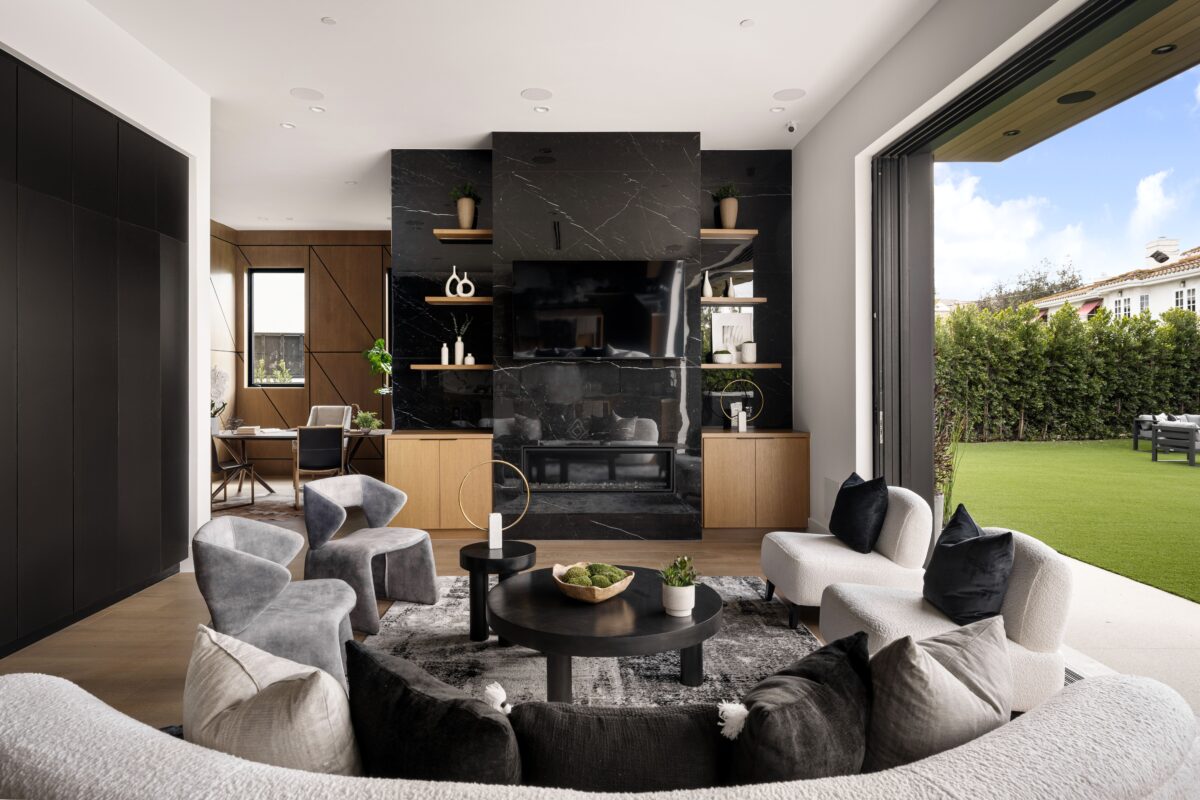
These days, American homeowners are embracing opposing design philosophies when it comes to their residential spaces. A subtle shift from “less is more” to “more is more” is quite apparent. What it means is that in the coming years, we are likely to see more of “maximalism” in residential architecture.
It’s true that for decades, contemporary American homes prioritized minimalist architecture. Open plans, clean lines, and neutral colors were people’s choices. However, an ongoing bold wave of maximalism is countering that norm. The focus is now on abundance, palette, and rich decorative details.
Recent surveys highlight that the U.S. architectural services market was valued at $73.01 billion and is speculated to grow at a 4.2% CAGR from 2024 to 2030. Design preferences are becoming increasingly polarized between the minimalist and maximalist philosophies.
According to a 2022 survey, minimalism was still dominating the daily preferences of American residents. In contrast, emerging data unveil increasing dissatisfaction with sterile aesthetics, as homeowners look for spaces that contemplate individual identity and emotional connection.
Simply put, maximalism constitutes the antithesis of minimalist restraint, characterized by layered textures, bold colors, and an organized abundance that celebrates personal expression. Understanding these evolving preferences facilitates architects in navigating client expectations and delivering spaces that align aesthetic appeal with functional requirements.
The Progression and Challenges of Minimalist Architecture
Simplicity, practicality, and spatial efficiency are at the heart of minimalist architecture’s prominence. The shift prioritized open floor plans, geometric forms, and the incorporation of natural light to create balanced living environments. Neutral palettes of grays, whites, and earth tones define minimalist spaces, while natural materials like stone and glass add authenticity.
For architectural firms, embracing minimalism was due to its cost-effectiveness and universal appeal. Besides, fewer design elements curtailed construction complexity and streamlined maintenance needs, which appealed to busy homeowners. This design philosophy aligns with sustainability objectives through reduced material usage and energy-efficient systems.
Nevertheless, detailed market research reveals a decline in satisfaction with minimalism among American homeowners. The sterile look and lack of customization contributed to emotional disconnection from living spaces. Younger demographics, especially, rejected minimalism’s limitations on cultural representation and self-expression over time.
The Revival of Maximalism in American Residential Design
- Integration of Bold Color: Maximalist designs welcome vibrant colors. They can create visual excitement and emotional stimulation across all types of residential spaces.
- Pattern Layering: Tactical fusion of dynamic patterns involving geometrics, florals, and cultural motifs supplements depth and visual interest to interior settings.
- Richness of Texture: Numerous fabric textures, such as silk, velvet, and natural fibers, establish tactile experiences that enhance sensory engagement.
- Personal Collections: Tailored displays of vintage pieces, artwork, and meaningful objects convert homes into personalized galleries that resonate with individual stories.
It is crucial to understand that maximalism is beyond just aesthetic choices. Instead, it embodies psychological needs for identity, comfort, and emotional connection. The notion of dopamine décor signifies how vibrant spaces can uplift mood and well-being through visual stimulation. Moreover, research validates that maximalism is intricately connected to fostering creativity and self-expression. Through this, maximalist architectural settings strive to provide psychological comfort.
Undoubtedly, this shift gained significant momentum, thanks to social media platforms, by portraying eclectic interiors and personal design storytelling. These platforms aided homeowners in discovering bold combinations that were once considered unconventional. Consequently, professional architectural designers adapted to client demands for homes that echo personality instead of trends.
Regional Differences in Design Preferences
It is evident that geographic elements impact architectural style adoption considerably throughout the U.S. In this provision, there is something that needs to be understood clearly. Colonial and traditional American styles account for approximately half of the for-sale market. This demonstrates regional heritage and cultural preferences. Alternatively, Mediterranean styles are dominant in posh markets like Miami and Los Angeles, commanding premium prices.
When it comes to the northeastern regions, the inclination is toward integrating conventional elements with contemporary functionality. Shutters in coastal communities and Dutch Colonial influences exhibit regional vernacular traditions. In the southwestern region, homeowners are embracing adobe-style exteriors and earth-tone colors that accompany desert landscapes. Therefore, variations in architectural design preferences in the different areas are noticeable.
Another essential factor to consider is that millennial household formation will drive approximately 70% of new construction demand through 2030. However, preferences are expected to differ by region. Additionally, Sun Belt metros fascinate buyers looking for walkable communities with smart home integration. Overall, urban areas are showcasing more and more acceptance of maximalist choices, while suburban markets are still maintaining conservative design options.
Impact of Technology on Design Evolution
Undoubtedly, precision is central to prefabrication. In a factory environment, specialized equipment can cut and assemble modules according to exact specifications. This leads to extremely rigid tolerances.
Factories also incorporate continued checks, where inspectors authenticate quality at every production stage and compare output with validated models. This level of vigilance, often through detailed checklists, helps catch defects on the factory site rather than during construction. As a result, there are fewer expensive field modifications.
Impact of Technology on Design Evolution
- Smart Home Integration: Remember that contemporary residential architecture implements technology systems that sustain both minimalist efficiency and maximalist complexity with the help of automated control.
- Virtual Reality Design: Cutting-edge visualization tools allow clients to experience maximalist spaces ahead of construction. This reduces design discrepancies and implementation hazards.
- Modular Construction Systems: Prefabricated elements combine both minimalist simplicity and maximalist richness through adjustable assembly methods.
- Innovation of Sustainable Material: New-age eco-conscious materials support both design philosophies while satisfying environmental performance requirements.
As for technological impact, it is essential to talk about Building Information Modeling. It has drastically revolutionized the entire architectural design landscape. BIM enables error-free visualization of complex maximalist compositions. In fact, BIM tools facilitate architects in examining bold palette combinations and pattern interactions before actual construction. Moreover, smart home systems collaborate effortlessly with both design approaches, delivering practicality without sacrificing aesthetic vision.
Last but not least, VR proves to be especially valuable for maximalist projects. This is simply because visual complexity calls for meticulous coordination. Clients get to experience suggested spaces immersively, fostering informed choices regarding bold design elements. Evidently, this technology decreases revision cycles and elevates project satisfaction rates.
Market Trends and Economic Implications
Now, let’s look into how the market is likely to behave in the coming years. Evidence confirms that the residential construction market in the U.S. has reached $1.35 trillion in 2025. By the end of 2030, this market is expected to be valued at around $1.69 trillion.
Besides, the condominium and apartment segments are predicted to grow 6.23% every year, highlighting urban density priorities and changing lifestyle demands. It is also worth mentioning that single-family homes are changing with smaller sizes and more shared community features.
Renovation projects are growing by 5.76% each year as homeowners update spaces to match new tastes. Energy retrofits cost about $25,000–$50,000 and often include design changes. However, maximalist renovations usually need bigger budgets because of custom finishes and complex installations.
Since minimalist approaches usually need fewer resources, material costs have an impact on the final design choice. Conversely, maximalist projects necessitate diverse materials and niche craftsmanship, which enhance project complexity and overall expenses. Yet, maximalist spaces seldom get higher resale values because of their unique character and emotional appeal.
Professional Implementation Strategies
- Client Education: Educating clients about the practical and psychological implications of both design philosophies should be the foremost priority for architectural firms. It guarantees informed decision-making.
- Hybrid Approaches: Blending minimalist backgrounds with maximalist focal points helps create balanced spaces that align with differing preferences without overwhelming occupants.
- Material Choice: Materials should be chosen strategically. They support either design philosophy while upholding performance criteria for endurance, maintenance, and sustainability.
- Space Planning: Efficient space planning fits both minimalist practicality and maximalist storage protocol by means of innovative design solutions.
It must be acknowledged that for successful implementation, it is critical to understand the lifestyle patterns of clients and their individual emotional needs. Clients preferring minimalism usually seek efficiency and calm settings. On the contrary, minimalist clients search for expression and stimulation. So, professional architects need to balance these demands through thoughtful space planning and material selection.
Concerning maximalist projects, quality control is of significant value because of enhanced complexity and coordination needs. To achieve cohesive outcomes, multiple patterns, colors, and textures should be precisely executed. Additionally, third-party monitoring would ensure the design vision translates successfully into a constructed reality.
Conclusion
Clearly, the transition from minimalism to maximalism relates to more profound cultural shifts in American residential architecture beyond simple aesthetic choices. Market research assures that the demand for personalized spaces is growing. This resonates with individual identity and maintaining practical performance standards. The residential construction market now accommodates both minimalism and maximalism through different project types and region-specific preferences that align with local cultural influences.
What modern architects need to do is navigate these opposing trends by grasping clients’ psychological desires and lifestyle needs. Uppteam’s robust architectural design services can deliver the specialized expertise imperative to steer these changing tastes in U.S. residential architecture. Ultimately, Uppteam‘s remote support allows firms to provide both minimalist efficacy and maximalist abundance. Alongside, we ensure optimal project quality, schedule adherence, and client satisfaction throughout the design and construction phases.

















